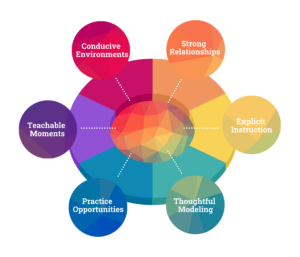Educators across the nation are now faced with the unique challenge of distance learning, all while living through a global pandemic. Are my students healthy? How is their mental health? How do I do this distance learning thing? How do I support my colleagues or staff? Why am I washing dishes again?
Distance learning in a global pandemic is a new reality for many of us, but at TransformEd we believe this time offers an opportunity to prioritize students’ social and emotional learning (SEL). If not now, when? We encourage educators to take the time to explicitly teach and thoughtfully model these skills for our youth and one another.
 Our SEL Integration Approach defines explicit instruction as time spent directly discussing an SEL competency: what it is, why it’s important, and how to develop it. Thoughtful modeling provides a pre-planned example of thinking or acting that students can observe, unpack, and adopt from adults or peers. Though the SEL Integration Approach was originally developed to integrate SEL into the classroom, we believe it is imperative that educators continue to intentionally set up the conditions for students to thrive, even in this virtual environment.
Our SEL Integration Approach defines explicit instruction as time spent directly discussing an SEL competency: what it is, why it’s important, and how to develop it. Thoughtful modeling provides a pre-planned example of thinking or acting that students can observe, unpack, and adopt from adults or peers. Though the SEL Integration Approach was originally developed to integrate SEL into the classroom, we believe it is imperative that educators continue to intentionally set up the conditions for students to thrive, even in this virtual environment.
Below are a couple of strategies that educators can use to continue to explicitly teach and model social and emotional competencies:
If you are looking for explicit lessons on SEL competencies that are responsive to life during COVID-19, check out EQ in Your PJs. Similarly, students can engage with SEL content through Newsela SEL Articles or create a Toolbox of Care from Facing History and Ourselves, where they identify ways to take care of themselves and others. Consider Pure Edge for health, wellness, and mindfulness curriculum, as well as teaching students about their brain’s capacity for growth.
In addition to explicitly teaching different SEL skills, we recommend that educators intentionally model for students what those skills can look like. For example, stress management can take different forms given students age levels and life experiences. Educators can model what stress management looks like for them and they can invite others’ to share how they cope with stress. Here are tools educators can use to model and normalize the naming and processing of emotions through check-ins using strategies such as Roses & Thorns, a daily virtual check-in, the Mood Meter exercise/activity from the Yale Center for Emotional Intelligence, or a simple student survey on digital learning such as this MS/HS Google Forms Survey. Don’t forget to check in with yourself, as well. Consider sharing some of the ways that you are practicing self-care during this time, and encourage students to share their own strategies. Finally, set and maintain boundaries using the “when/then” strategy, and model for students how they too can start setting boundaries when possible.
Whether it is fear of not knowing how our students and families are doing, or the stress of managing multiple needs at home, we are all experiencing some degree of anxiety, fear, stress, and uncertainty. Whatever your story may be, we hope you are able to take care of yourself and model for our youth what taking care of ourselves and our loved ones can look like in these unprecedented times. For more ideas on integrating SEL remotely, keep an eye out for our final blog post on creating practice opportunities that promote social and emotional development and embracing teachable moments with our students.


